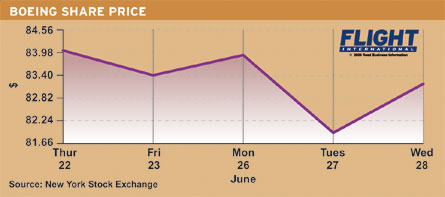By Helen Massy-Beresford in London
When Connexion by Boeing went on line in 2003 it was billed as a major step forward for the in-flight connectivity market, enabling the first wave of customer airlines to steal a march on their competitors while promising substantial revenues for the US manufacturer.
Expectations were high, despite then Airbus chief executive Noël Forgeard’s famous dismissal of Boeing’s “flashy diversification” strategy at the previous year’s Singapore air show.
So why, just three years later, is Boeing halting sales and taking a hard look at the case for persevering with its underperforming broadband communications business unit? And does the lukewarm response from consumers signal trouble ahead for the next grand project on the horizon – in-flight mobile phone services?
Boeing says the market for Connexion simply “has not developed satisfactorily” and adds that it is talking to operators in all sectors of the aviation industry, including the military, “to assess the current state of the market and develop plans that address market conditions”. But the manufacturer insists that the system is “performing very well and users are pleased with it”.

Early airline adopters seem to agree. Lufthansa, whose passengers were the first to send and receive emails on transatlantic flights when the service was launched in 2003, remains confident it will be able to continue to offer the service. “Our customers are very happy with the broadband connectivity on board,” it insists. The Star Alliance carrier is not revealing whether the pricing of the service put off potential users.
One London-based airline analyst says: “It’s a similar situation to when seat-back phones were introduced on US airlines – no one used them.” Another factor could be that some passengers welcome the chance to be out of contact on a flight, he adds. But as technology continues to improve, enabling cheaper and simpler on-board communications services, other product offerings could see more success.
Lufthansa Technik, which supervises the installation of the Connexion system on Airbus aircraft, argues that the equipment is simple to install, maintain and use, and that there remains a market for in-flight communications. “Cabin modifications and connectivity will be a growing business. It’s a small, but interesting and innovative portion of our business,” it says.
Boeing says it could consider a partnering agreement or straight sale of Connexion, either of which could “open up new avenues”. But “all options are still on the table”, and one of these is terminating the service.
The question mark now hanging over this flagship connectivity product has inevitably raised doubts over prospects for the in-flight communications market in general. But competing providers predictably argue that there remains a market for Connexion and in-flight telephony products.
OnAir chief executive George Cooper says his company’s product, which should from next year enable passengers to use their own mobile phones on board aircraft, is different to Boeing’s. “The two companies have taken a fundamentally different approach to developing passenger communication services, from the very basics of the technology used, to the most fundamental element: the needs and preferences of the target market,” he says.
The key to OnAir’s business model is that it allows for greater passenger flexibility, says Cooper. “Our model recognises passengers’ differing requirements, ranging from using their mobile or BlackBerry-type devices, to accessing webchat and webmail through the in-seat in-flight entertainment system, to full Wi-Fi internet and virtual private network access through their laptops,” Cooper says. The company plans to introduce GSM and GPRS services in western Europe next year and data services on long-range aircraft in 2008. It is carrying out trials with Air France this year, and TAP Portugal and BMI are set to begin using the service next year.
“The response to our plans seems to confirm that the OnAir approach will meet mainstream market needs for an economically viable set of services appropriate to the diverse on-board communication needs that airline passengers want,” Cooper says.
But earlier attempts at in-flight telephony have floundered: just last week, US-based seat-back handset provider Verizon Airfone, whose customers include Continental Airlines, Delta Air Lines, United Airlines and US Airways, said it would end its service on commercial airline flights by the end of 2006 to focus on its “core business”. And doubts remain for future products: a survey published last week by the International Airline Passengers Association suggests that there could be widespread opposition to the introduction of mobile phones on aircraft from passengers who fear on-board telephony would be disruptive, anti-social and possibly even dangerous.
In the meantime, Boeing is determined not to be rushed as it decides on the future of Connexion: “The full extent of possible changes to the business model associated with this evaluation process won’t be decided until meetings with customers have taken place,” it says.
Source: Flight International























